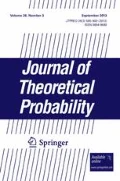Abstract
Random Cantor sets are constructions which generalize the classical Cantor set, “middle third deletion” being replaced by a random substitution in an arbitrary number of dimensions. Two results are presented here. (a) We establish a necessary and sufficient condition for the projection of ad-dimensional random Cantor set in [0,1]d onto ane-dimensional coordinate subspace to contain ane-dimensional ball with positive probability. The same condition applies to the event that the projection is the entiree-dimensional unit cube [0,1]e. This answers a question of Dekking and Meester,(9) (b) The special case of “fractal percolation” arises when the substitution is as follows: The cube [0,1]d is divided intoM d subcubes of side-lengthM −, and each such cube is retained with probabilityp independently of all other subcubes. We show that the critical valuep c(M, d) ofp, marking the existence of crossings of [0,1]d contained in the limit set, satisfiesp c(M, d)→p c(d) asM→∞, wherep c(d) is the critical probability of site percolation on a latticeL d obtained by adding certain edges to the hypercubic lattice ℤd. This result generalizes in an unexpected way a finding of Chayes and Chayes,(4) who studied the special case whend=2.
Similar content being viewed by others
References
Aizenman, M., and Grimmett, G. R. (1991). Strict monotonicity of critical points in percolation and ferromagnetic models.J. Stat. Phys. 63, 817–835.
Barsky, D. J., Grimmett G. R., and Newman, C. M. (1991). Percolation in half-spaces: Equality of critical probabilities and continuity of the percolation probability.Prob. Theor. Rel. Fields 90, 111–148.
Barsky, D. J., Grimmett, G. R., and Newman, C. M. (1991). Dynamic renormalization and continuity of the percolation transition in orthants. InSpatial Stochastic Processes. K. Alexander and J. Watkins (Eds.). Birkhäuser, Boston, pp. 37–55.
Chayes, J. T., and Chayes, L. (1989). The large-N limit of the threshold values in Mandelbrot's fractal percolation process.J. Phys. A: Math. General 22 L501-L506.
Chayes, J. T., Chayes, L., and Durrett, R. (1988). Connectivity properties of Mandelbrot's percolation process.Prob. Theor. Rel. Fields. 77, 307–324.
Chayes, J. T., Chayes, L., Grannan, E., and Swindle, G. (1991). Phase transitions in Mandelbrot's percolation process in three dimensions.Prob. Theor. Rel. Fields 90, 291–300.
Chayes, J. T., Chayes, L., and Newman, C. M. (1987). Bernoulli percolation above threshold: An invasion percolation analysis.Ann. Prob. 15, 1272–1287.
Dekking, F. M., and Grimmett, G. R. (1988). Superbranching processes and projections of random Cantor sets.Prob. Theor. Rel. Fields. 78, 335–355.
Dekking, F. M., and Meester, R. W. J. (1990). On the structure of Mandelbrot's percolation process and other random Cantor sets.J. Stat. Phys. 58, 1109–1126.
Falconer, K. J. (1989). Projections of random Cantor sets.J. Theor. Prob. 2, 65–70.
Falconer, K. J. (1990).Fractal Geometry-Mathematical Foundations and Applications. John Wiley, Chichester, England.
Graf, S., Mauldin, R. D., and Williams, S. C. (1987). Exact Hausdorff dimension in random recursive constructions.Memoirs of the American Mathematical Society, No. 381.
Grimmett, G. R. (1981). Critical sponge dimensions in percolation theory.Adv. Appl. Prob. 13, 314–324.
Grimmett, G. R. (1989).Percolation. Springer-Verlag, New York.
Grimmett, G. R., and Marstrand, J. M. (1990). The supercritical phase of percolation is well behaved.Proc. Roy. Soc. (London) A 430, 439–457.
Guth, A. H., and Weinberg, E. J. (1983). Could the universe have recovered from a slow first-order phase transition?Nucl. Phys. B 212, 321–364.
Kesten, H. (1989). Supercritical branching processes with countably many types and the size of random Cantor sets. InProbability, Statistics, and Mathematics, Academic Press, New York, pp. 103–121.
Kesten, H., and Zhang, Y. (1990). The probability of a large finite cluster in supercritical Bernoulli percolation.Ann. Prob. 18, 537–555.
Mandelbrot, B. B. (1983).The Fractal Geometry of Nature. W. H. Freeman, San Francisco.
Menshikov, M. V. (1987). Quantitative estimates and rigorous inequalities for critical points of a graph and its subgraphs.Theor. Prob. Appl. 32, 544–547.
Author information
Authors and Affiliations
Rights and permissions
About this article
Cite this article
Falconer, K.J., Grimmett, G.R. On the geometry of random Cantor sets and fractal percolation. J Theor Probab 5, 465–485 (1992). https://doi.org/10.1007/BF01060430
Received:
Revised:
Issue Date:
DOI: https://doi.org/10.1007/BF01060430




